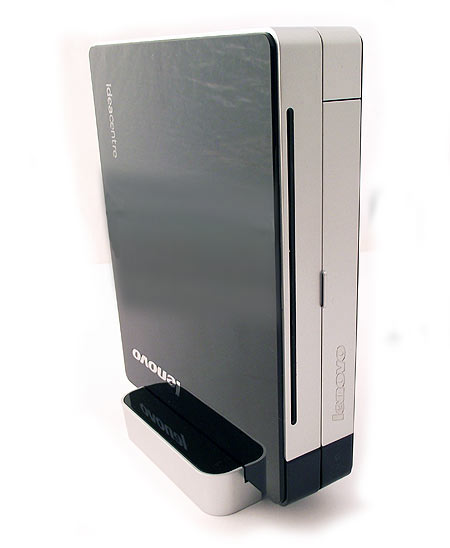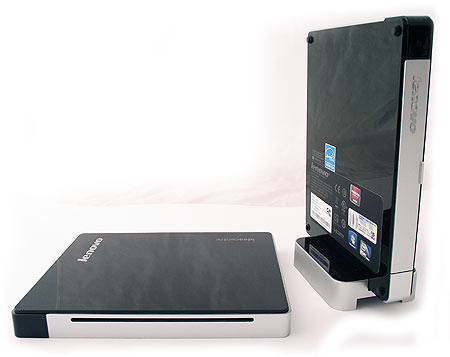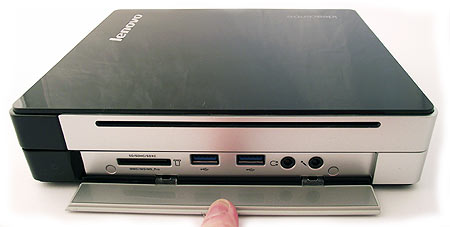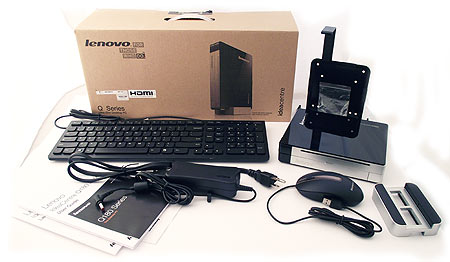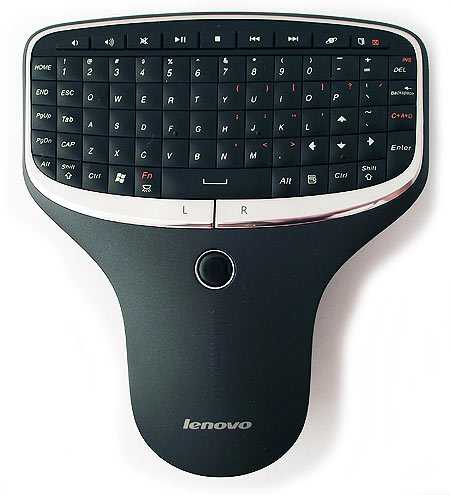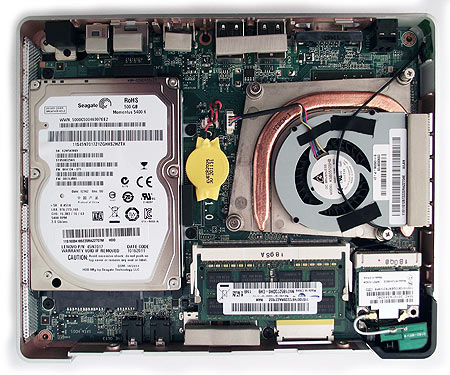Does Size Matter? Four Very Small Nettops Get Reviewed
We're comparing four diminutive PCs: ASRock’s Vision HT, Jetway’s Mini-Top JBC700, Lenovo’s Q180, and Zotac’s Zbox Nano XS AD11 Plus. Despite their similar sizes, each tiny computer offers a unique feature set. Are any of them right for you?
Lenovo Q180 31102BU
This is our first submission from Lenovo, and the company surprised us with some of the Q180's attributes. First, it's available without an optical drive for as little as $340 from Newegg, including an operating system and wireless remote/keyboard. In that trim, it's best described as a nettop. However, you can get it with an attached optical drive and have it function as a home theater-oriented PC, too.
Our sample is equipped with the optical option, along with Windows 7 Home Premium 64-bit and a full-sized keyboard/mouse. Configured like so, the machine sells for $430 from lenovo.com (though it's worth noting a $100 discount on the company's site at the time of writing, bringing the price down to $330).
Inside, you'll find an Atom D2700 (dual-core, Hyper-Threaded, and running at 2.13 GHz). It's notably faster than the 1.8 GHz Atom D525 we’ve tested in the past, and a CPU we've previously found to be quite sluggish. The extra 333 MHz makes a notable difference, and this platform is more responsive than its predecessor. Moreover, the Q180 sports a discrete Radeon HD 6450A GPU running at 625 MHz and complemented by 512 MB of DDR3 memory set to 800 MHz.
The Q180 is housed in a plastic enclosure with glossy black sides and metal-colored perimeter. The optical drive appears to be part of the unit when it's attached. But it's removable if the USB dongle is taken off and the nettop pried away. Be careful: this involves considerable force.
Despite its plastic, the Q180 looks very well put-together. The door covering front-mounted I/O opens easily, but snaps back into place perfectly with the help of magnets. Measuring 7.5” x 6” x 1.5” (7.5” x 6” x 0.75” with the optical drive removed), Lenovo's effort is quite small, and only Zotac's tiny Zbox is more diminutive.
The Q180 can sit flat or upright on a stand. The stand is built so that you can attach one side to accommodate just the nettop. The other fits with the optical drive connected.
The back of the PC hosts HDMI and VGA outputs, four USB 2.0 ports (the optical drive monopolizes one of them), gigabit Ethernet, optical audio output, and a power supply interface.
Get Tom's Hardware's best news and in-depth reviews, straight to your inbox.
Up front, a small door hides a memory card reader, two USB 3.0 ports, and 1/8" speaker/microphone jacks. The slot-load optical drive is visible as well. System power and disc-eject buttons are on the left side of the machine, made of clear black plastic and illuminated when the system is running.
Lenovo's bundle is the round-up's most robust, even including a mouse and keyboard. Like the Q180 itself, these are high-quality peripherals, conveying demonstrating good tactile response. They're not cheap add-ins the company is trying to pawn off.
In addition, you get plenty of documentation, the stand, and a VESA mount. This is also the only configuration in our story that includes a copy of Windows 7. While some Q180 models do come with a wireless remote, the 31102BU doesn’t (although Lenovo sent one for testing anyway).
Lenovo sells an optional N5902 multimedia remote with keyboard for $80 off of its website. It features a full QWERTY keyboard that lights up when you're using it, along with a touch-based mousing surface. Most unique, all of that fits comfortably in the palm of one hand.
Unlike most of the value-added remotes we see come through the lab, this one is RF-based, working equally well in front or behind the receiver. We had no problem using it from anywhere in a 15-foot radius around the Q180. It’s a great little remote and keyboard combo. My only gripe is that the mousing surface requires a number of swipes to cover the width of a 1920x1080 screen.
The Q180 doesn’t come with instructions for taking it apart. But it's not a difficult process, as long as you have small Phillips and standard screwdrivers.
Opening it up first requires removing the optical drive. Then, three of the rubber footpads have to be pulled out for access to the screws beneath them. Two screws holding the VGA port in place must also be removed. And finally, two screws under the front door must be taken off (these are covered with case-colored stickers). After all of that, tug on the top to lift it, giving you access to one SO-DIMM and the 2.5” SATA drive. Lenovo includes a single 4 GB stick of 533 MHz memory and a Seagate Momentus 5400.6 hard drive.
The firmware is primarily used for turning peripherals and features on or off. There are no performance adjustments of which to speak. Considering the hardware contained within, we're really not concerned (or surprised).
Current page: Lenovo Q180 31102BU
Prev Page Jetway Mini-Top JBC700C9JG Next Page Zotac Zbox Nano XS AD11 PlusDon Woligroski was a former senior hardware editor for Tom's Hardware. He has covered a wide range of PC hardware topics, including CPUs, GPUs, system building, and emerging technologies.
-
Nintendo Maniac 64 So I'm guessing there aren't any nettops yet that use the low-voltage Trinity APUs? (17w A6-4455M and 25w A10-4655M)Reply -
daglesj Beware with the Lenovo Q180 if you buy the barebones DOS version to install Windows 7 64bit on it.Reply
The Audio doesn't work. The drivers Lenovo have up on the site are incorrect for 64bit. So far they haven't got round to changing it after 6 months.
If you buy the version with Windows 64bit installed it works. But they just wont release the right driver. -
The big problem with net tops is longevity and lack of upgrade abilities. If all you plan to do with them is surf the web,send email, chat and watch 2D video. You most likely won't care what hardware is in them. But that's not the negative about these small form factors. Its heat, and a question of how that heat will affect the hardware in such a small form? Not to mention the small PSU's and the question of why would you buy one of these over a decent well designed notebook? Even if you like the form factor and want to run Linux on one of these. Chances are Linux will challenge you on some problem with the hardware.Reply
-
daglesj For day to day office work they do the job perfectly. I know quite a few businesses that are keen to drop their old 130W desktop boxes for something easier on the power bill. I rolled out a load of Atom ION boxes about 3 years ago and all of them are still going strong in some quite challenging environments. A few of them were even overclocked to give a little extra pep and no problems yet.Reply
The main thing that holds these boxes back are the HDDs. They still keep slipping 5400rpm drives in them. You put a 120GB SSD in there and you have a near perfect general office PC. -
silverblue Looking at the D2700 vs. the 450 reminds me of days gone by with the P4D and the Athlon 64 X2. The higher clock speed plus HT of the Atom helps a lot with encoding but despite its clock speed disadvantage, the 450 easily holds its own.Reply
The next generation of both these CPU families would be worth watching out for. -
jaquith I've been debating about purchasing a MINI PC vs Building, sadly one of my HTPC's just recently took a swan dive. So do I purchase something like the ASRock Vision HT for ~$700+ ($800), Build or Repair?!Reply
The only potential drawback to these MINI PC's as an HTPC is lacking of an internal 'TV Tuner' option. However, since Cable DVR's are very common place now the 'TV Tuner' need is getting smaller every day. I have Verizon FiOS and the newer black DVR's and a HTPC to record requires a CableCARD and PCIe CableCARD e.g. Ceton InfiniTV 4 but then you run into oddball things like "Copy Once."
The Pro's & Con's are all from their size, but ~$700+ is a huge price and IMO reduces the demand. The only complete system in this article is the Lenovo Q180, the ASRock Vision HT 821B requires some form of OS and sure there's 'free' OSes but Windows 7 Home Premium OEM 64-bit will add an additional $100.
Any of these listed can be used as a simple Desktop replacement. The workaround for storage is to either purchase a large capacity 'drive' (SSD or HDD) that can 'fit' or some form of external storage including an external drive (USB or eSATA if applicable) or Windows Home Server or similar network storage device. -
chewy1963 silverblueLooking at the D2700 vs. the 450 reminds me of days gone by with the P4D and the Athlon 64 X2. The higher clock speed plus HT of the Atom helps a lot with encoding but despite its clock speed disadvantage, the 450 easily holds its own.The next generation of both these CPU families would be worth watching out for.Reply
Just about the same performance between them back in the day. Of course it's different OS's and software, but, that was from the good ole days when Athlon 64 x2 ruled the x86 performance race. -
stevelord I bought an Asus nettop last year from Walmart. And despite putting a SSD in it + 4GB of memory, it crawled at even loading web pages...especially forums. Wife noticed the speed difference and after lots of complaining sent me back to return it.Reply
-
cleeve Nintendo Maniac 64So I'm guessing there aren't any nettops yet that use the low-voltage Trinity APUs? (17w A6-4455M and 25w A10-4655M)Reply
I couldn't find any, but this article has been in the works for a while so some might have cropped up. -
cleeve jaquithThe only potential drawback to these MINI PC's as an HTPC is lacking of an internal 'TV Tuner' option.Reply
The Jetway Mini-Top in this article *does* have an internal TV tuner option. :)
